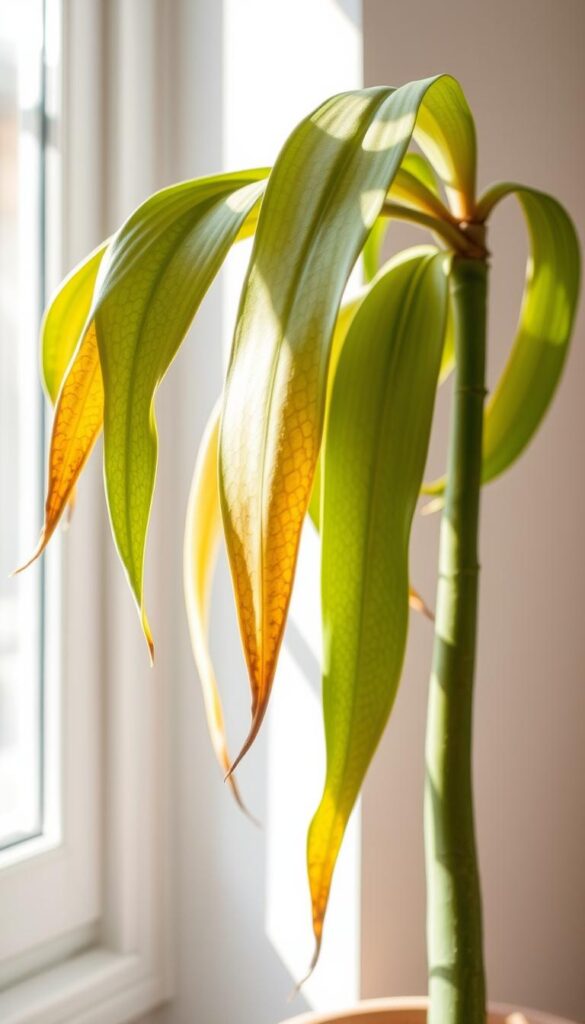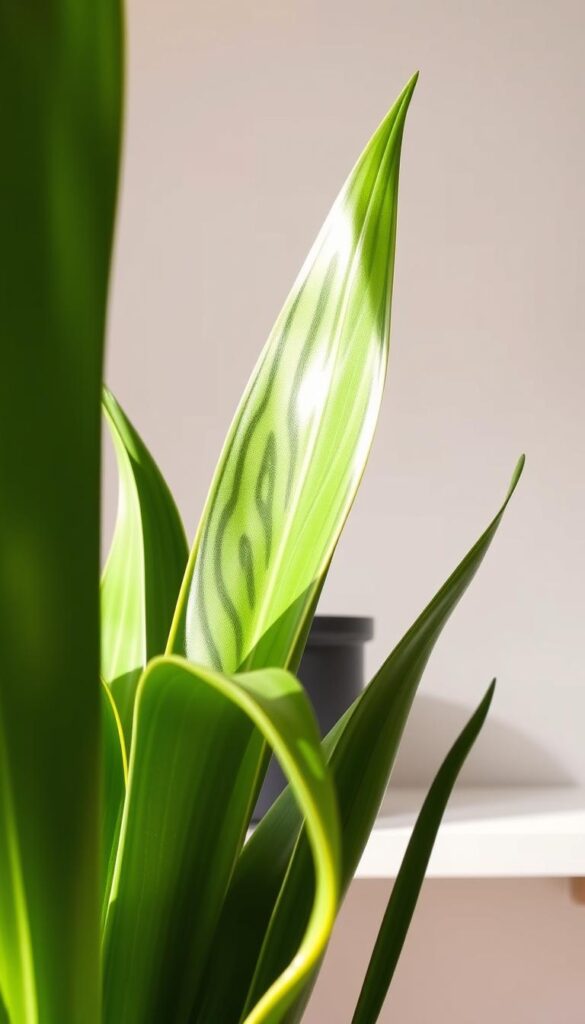Have you ever looked at your snake plant and wondered, “Why are its leaves turning yellow?” You’re not alone! This common issue can be puzzling, especially for those new to plant parenthood. Snake plants, known for their resilience, can still show signs of stress through yellowing leaves.
According to experts like Matt Slaymaker, yellowing leaves can signal both natural aging and underlying problems. Overwatering is often the main culprit, as snake plants prefer soil that’s dry to the touch between waterings. Using a well-draining pot and the right soil mix can help prevent root rot, a common cause of yellow leaves.
Stay tuned as we dive into diagnosing the issue and practical fixes to restore your plant’s health. With the right care, your snake plant can thrive and remain a stylish, low-maintenance addition to your space.
Understanding the Signs: Yellow, Brown, and Curling Leaves
Have you noticed your snake plant showing signs of distress through its leaves? Yellow, brown, or curling leaves can indicate both natural processes and underlying issues.
Distinguishing Natural Aging from Problematic Symptoms
Snake plants, like all living things, experience a natural life cycle. As older leaves age, they may turn yellow and eventually die, making way for new growth. This process is entirely normal and part of their development.
However, if yellowing leaves are widespread or accompanied by other symptoms like brown edges, it may signal a problem. Root rot from overwatering or pest infestations are common culprits that require attention.
Recognizing Stress Indicators in My Snake Plant
Leaf stress can manifest in various ways. Brown edges or curling foliage often point to environmental factors, such as too much direct sunlight or soil that’s too dry. These signs are your plant’s way of communicating its needs.
It’s important to assess whether yellowing is an isolated incident or a broader issue. If multiple leaves are affected, it may indicate a more serious condition that needs addressing.
- Older leaves naturally turning yellow as new growth emerges.
- Yellowing accompanied by brown edges or curling, suggesting stress.
- Isolated yellow leaves versus widespread yellowing across the plant.
By understanding these signs, you can adjust your care routine to prevent further damage and keep your snake plant thriving.
Why Is My Snake Plant Turning Yellow? Diagnosing the Problem
Yellowing leaves on your snake plant can be puzzling, but they often point to specific issues that you can address. To diagnose the problem, start by examining the soil moisture. Stick your finger into the soil up to the first knuckle. If the soil feels damp, it may be waterlogged, which can cause root rot and yellow leaves. If it’s dry, your plant might need more water.
Nutrient balance is another key factor. A lack of essential nutrients or overfertilizing can lead to yellowing leaves. Use a balanced fertilizer during the growing season to provide necessary nutrients without overloading the soil.
Light exposure also plays a role. While snake plants prefer bright, indirect light, too much direct sunlight can scorch the leaves, turning them yellow. On the flip side, insufficient light may cause the leaves to lose their vibrant color and become weak.

| Cause | Signs | Solution |
|---|---|---|
| Overwatering | Soft, mushy stems; yellow leaves | Allow soil to dry completely between waterings |
| Underwatering | Wilted, yellow leaves | Water thoroughly, ensuring good drainage |
| Nutrient Deficiency | Yellow leaves with slow growth | Fertilize with a balanced formula during the growing season |
| Too Much Direct Sunlight | Burned, yellow leaves | Move plant to a spot with bright, indirect light |
By systematically checking water, nutrients, and light conditions, you can identify the root cause of the yellowing leaves and take corrective action to restore your plant’s health.
Optimizing My Care Routine: Watering, Soil, and Sunlight
Adjusting your care routine is key to preventing yellow leaves and promoting healthy growth. By focusing on watering techniques, soil quality, and sunlight exposure, you can create an ideal environment for your snake plant to thrive.
Implementing Proper Watering Techniques and Drainage
Watering is one of the most critical aspects of snake plant care. Overwatering can lead to root rot, causing leaves to turn yellow. To avoid this, water your plant thoroughly, allowing the soil to dry completely between waterings. Ensure your pot has drainage holes to prevent waterlogged soil.
Selecting the Best Soil Mix and Pot for My Plant
The right soil and pot can make a big difference. Use a well-draining soil mix, adding perlite or sand to improve drainage. A terracotta pot is ideal as it allows the soil to breathe, reducing the risk of root rot and yellowing leaves.
Adjusting Light Exposure for Balanced Growth
Snake plants prefer bright, indirect light. Direct sunlight can scorch the leaves, causing them to turn yellow. Place your plant near an east- or west-facing window to ensure it gets the right amount of light without direct exposure.
By optimizing watering, soil, and sunlight, you can prevent yellowing leaves and help your snake plant grow strong and healthy. Regular monitoring and small adjustments to your care routine will keep your plant thriving.
Troubleshooting Common Issues: Pests, Root Rot, and Nutrient Deficiencies
Identifying and solving common problems can help restore your plant’s health. Let’s explore how to tackle these issues effectively.
Managing Pests Like Spider Mites and Mealybugs
Spider mites and mealybugs can cause significant damage to your snake plant. Regularly inspect the leaves for tiny moving dots or white, cottony patches. Use a cotton swab dipped in rubbing alcohol to gently remove these pests. Isolate infected plants to prevent infestations from spreading.
Addressing Root Rot and Nutrient Imbalances
Root rot often results from overwatering. If you suspect root rot, repot your snake plant in fresh, well-draining soil, and treat any infected roots. Ensure your pot has drainage holes to prevent waterlogged soil, which can exacerbate the issue.
Nutrient deficiencies can also cause yellowing leaves. Use a balanced fertilizer during the growing season to provide essential nutrients without overloading the soil. Avoid overfertilizing, as it can lead to further imbalances.

By addressing these common issues, you can help your snake plant recover and thrive. Regular monitoring and proper care will keep your plant healthy and vibrant.
- Inspect your plant regularly for pests.
- Use rubbing alcohol to remove pests.
- Repot in fresh soil if root rot is suspected.
- Ensure good drainage to prevent water retention.
Revitalizing My Snake Plant: Final Tips for Long-Term Health
Revitalizing your snake plant involves a combination of consistent care and vigilant monitoring. By addressing issues early and maintaining a balanced routine, you can help your plant regain its vitality and thrive long-term.
A key step is repotting your snake plant in a well-draining potting mix, which helps prevent root rot. Using a terracotta pot can also enhance soil breathability. Regular fertilization during the growing season provides essential nutrients, but avoid overfertilizing to prevent imbalances.
Monitor water and light exposure closely. Water only when the soil is dry to the touch, and ensure your plant gets bright, indirect sunlight. Avoid direct sunlight, which can cause leaves to yellow or become scorched.
Stay alert for pests like spider mites and mealybugs. Regular inspections and prompt treatment with rubbing alcohol can prevent infestations from taking hold. Gradual adjustments to your plant’s environment will support steady growth and overall health.
With dedication and the right approach, your snake plant will continue to be a beautiful, low-maintenance companion in your home. Remember, small, consistent efforts can make a big difference in your plant’s well-being.
